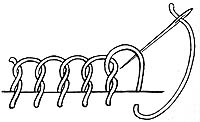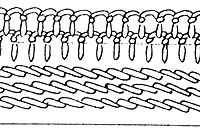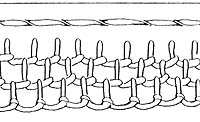|
Early Anglo-Saxon Clothing
Lesson #2: Page 6
Materials and Techniques:
Decoration.
 This
part of the lesson will be looking at the ways clothing was decorated.
It is an area which many modern reconstructions overdo, or do badly. This
part of the lesson will be looking at the ways clothing was decorated.
It is an area which many modern reconstructions overdo, or do badly.
The first thing to look at is where
decoration is applied to garments. Although patterned cloths
were sometimes used, it seems the Anglo-Saxons sid not apply large amounts
of decoration to the majority of a garment. #1
Decoration occurs only at edges and seams on Anglo-Saxon clothing.
Much of this decoration seems to serve a strengthening or reinforcing function
and is not purely decorative.
Braid
The commonest form of decoration known
from archaeology is the application of tablet weave. This may
be woven integrally with the cloth, or may be woven as a seperate braid
and sewn to the garment. Tablet woven braids could be of wool
or linen, although wool seems to be the more common variety.
These braids were usually fairly narrow, and made of fine fibres.
They were often brightly coloured and patterns ranged from simple diagonal
stripes and zig-zags to convoluted patterns of animals and foliage.
Very high class examples are brocaded with gold thread.
Tablet woven bands are found at cuffs, hems and neck openings, but seem
to be absent from seams. The braid is usually placed right
at the edge of the garment where its more hardwearing nature protects the
edge of the garment. The braid might be laid along the
edge and attached with a simple running stitch at each edge, or it might
be placed edge to edge with the garment and whip-stitched on.
Decorative Stitching
The other form of decoration known
is decorative stitching. There is no evidence for true
embroidered designs (as on later garments), although the term embroidery
is sometimes applied to these decorative stitches. This
method seems to have developed from the technique of using rows of stitches
to reinforce a hem or seam, but as time went by it became increasingly
decorative. In its simplest form it could be as basic as a
plain overcast hem executed in a contrasting coloured yarn.
However, other lines of stitching were also often added in parallel and
overlapping rows in a variety of colours. Most of these were
stitches generally associated more with sewing than true embroidery, including
buttonhole stitch, running stitch, tailor's stitch, back stitch, blanket
stitch and stem stitch. This type of decoration occurs
most commonly aling seams and at the edges of slits, etc. It
is less common on hems than braid.
 |
Basic buttonhole
stitch |
 |
Twisted buttonhole
stitch. |
 |
Buttonhole
stitch used as an 'embroidery' stitch. |

|
Tailor's Stitch,
also known as Tailor's Buttonhole Stitch, used as a decorative embroidery
stitch. |
 |
Hem sewn down
with double row of tailor's stitch and edged with rows of stem stitch. |
 |
Decorative
seam. Nearest the fabric join, tailor's stitch, and after this
blanket stitches through each loop in the previous line. |
 |
Decorative
edging sewn down with two rows of blanket stitch and one of tailor's stitch.
Along the edge stem stitch. |
Other Decorative Textile
Techniques
Some textile remains from archaeology
show that woven tapestry techniques such as soumak were known and used
in the Anglo-Saxon period, but all the examples found have been identified
as wall-hangings, cushion and pillow covers or bedcovers, they do not seem
to have been used for clothing. Early literature makes
many references to embroidered wall hangings, and certainly the Anglo-Saxon
seamstresses were famous for their skills at embroidery a few centuries
later. Whilst it seems likely that embroidered wall hangings
were known at this period it is unlikely such techniques were worked on clothing.
#2
1 This
is surprising since many other Anglo-Saxon items are awash with decoration
to the extent that one expert on Anglo-Saxon art described them as having
a 'horror vacuii' - a fear of empty spaces! However, all the
evidence we have points to relatively plain clothing. back
2 It
seems that true embroidery on clothes was an introduction from Byzantine
and Frankish fashions when Christianity arrived in England during the seventh
century. It probably did not need much of a leap for the skilled
Anglo-Saxon seamstress to transfer her skills from embroidered wall hangings
to embroidered clothing. back
Page
1 | Page 2 | Page
3 | Page 4 | Page
5 | Page 6 | Page 7
Bibliography
|







